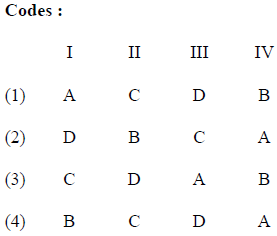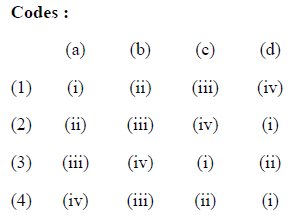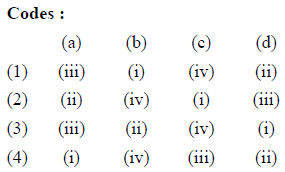LINGUISTICS
Paper – II
Note : This paper contains fifty (50) objective type questions of two (2) marks each. All questions are compulsory.
1. No particular linguistic form is naturally associated with any particular meaning, and the pairing that exists for meaning in each case is
(1) Universal
(2) Sound-induced
(3) Arbitrary
(4) Meaning-induced
2. A property of human language whereby it can be used to refer to contexts removed from the immediate situation of the speaker is called
(1) Arbitrariness
(2) Double articulation
(3) Displacement
(4) Complementarity
3. Assertion (I) : When linguists speak of rules, they are not referring to prescriptive rules.
Assertion (II) : Linguists try to formulate rules when they analyze language, rules that describe the actual language of some group of speakers and not some hypothetical language that speakers “should” use.
Codes :
(1) Both (I) and (II) are false.
(2) (I) is true, but (II) is false.
(3) (I) is false, but (II) is true.
(4) Both (I) and (II) are true.
4. Any language with a reasonably large number of speakers will develop
(1) into a homogenous system with no varieties to emerge.
(2) into regionally or socially distinctive varieties of language, identified by a particular set of words and grammatical structures.
(3) into an artefact.
(4) into a restricted code.
5. Words that sound alike are called
(1) Homographs
(2) Homonyms
(3) Homophones
(4) Homorganic
6. Languages can be described as “agglutinating”, or “isolating” or “inflecting” depending on their.
(i) Phonetic properties
(ii) Syllogis pattern
(iii) morphosyntactic structures
(iv) written forms and writing systems.
Codes :
(1) All four are true.
(2) All four are false.
(3) (i) and (iv) are false and (ii) and (iii) are true.
(4) (i), (ii) & (iii) are true and (iv) is false.
7. Match the following :


8. The grammatical category of ‘round’ in the sentence ‘the car went round the corner’ is
(1) Noun
(2) Adjective
(3) Verb
(4) Preposition
9. Idiolect can be referred to as a linguistic system of a/an
(1) Community
(2) Caste
(3) Profession
(4) Individual
10. Match the items in List – I with items in List – II


11. If in a compound no constituent functions as the head, it is called a/an
(1) Exocentric compound
(2) Endocentric compound
(3) Karmadharaya compound
(4) Tatpurusha compound
12. [f] and [ph] are distinct in terms of their
(i) places of articulation
(ii) manners of articulation
(iii) voicing patterns
(iv) phonemic status in the English language
Codes :
(1) (i) & (ii) are true, (iii) & (iv) are false.
(2) All are true except (iii).
(3) All are false except (iv).
(4) All are false.
13. Assertion (I) : Back sounds are articulated in the back part of the mouth.
Assertion (II) : Back sounds are articulated with the back part of the tongue.
Codes :
(1) Both (I) and (II) are correct.
(2) (I) is correct, but (II) is wrong.
(3) (I) is wrong, but (II) is correct.
(4) Both (I) and (II) are wrong.
14. Assertion (I) : Vowel sounds are high sonority sounds because of resonances provided by the air column in the oral chamber.
Assertion (II) : Vowel sounds are characterized by a combinations of fundamental tune and formats.
Codes :
(1) (I) is true & (II) is false.
(2) (II) is true and (I) is false.
(3) Both are true.
(4) Both are false.
15. Assertion (I) : The process of phonation determines the pitch of voice.
Assertion (II) : Phonation is dependent on the elasticity of vocal cords as well as the aerodynamics of Bernoulli’s effect.
Codes :
(1) Both (I) and (II) are true.
(2) Both (I) and (II) are false.
(3) (I) is true and (II) is false.
(4) (I) is false and (II) is true.
16. A set of segments that are specified by a fewer set of phonetic features constitute
(1) a natural class
(2) a natural hierarchy
(3) a natural ordering
(4) an unnatural class
17. A functional relationship between rules where the application of one rule creates a structural representation to which another rule is applicable is called
(1) Feeding relationship.
(2) Bleeding relationship.
(3) Counter feeding relationship.
(4) Counter bleeding relationship.
18. A term in phonetics and phonology which refers to the influence exercised by one segment of sound upon the articulation of another, so that the sounds become more alike or identical, is called
(1) Dissimilation
(2) Association
(3) Assimilation
(4) Cooperation
19. In many English compounds, the primary stress is located on the :
(1) whole word
(2) last constituent
(3) first constituent
(4) None of the above
20. A form that resembles a word but cannot stand on its own as a normal utterance is called a/an
(1) elitie
(2) suffix
(3) empty morph
(4) prefix
21. Which of the following is not a phrase in the sentence ?
“The old man gave the girl an apple.”
(1) The old
(2) The old man
(3) gave the girl an apple
(4) an apple
22. A group of syntactically related words where one of the words is functionally equivalent to the group as a whole indicating a definable ‘centre’ or ‘head’ inside the group is
(1) an endocentric construction
(2) an exocentric construction
(3) neither an endocentric or exocentric construction
(4) both endocentric as well as exocentric construction
23. Which of the following is not true of the Aspects model ?
(1) Base provides input to Deep structure.
(2) Transformational component is a part of Deep Structure.
(3) Strict sub-categorization and selectional restriction are contained in the Base component.
(4) Base contains the PS rewrite rules.
24. Assertion (I) : A Head parameter specifies the positions of heads within phrases.
Assertion (II) : The null subject parameter determines whether the subject of the clause can be suppressed.
Codes :
(1) Both (I) and (II) are true.
(2) Both (I) and (II) are false.
(3) (I) is true, (II) is false.
(4) (I) is false, (II) is true.
25. Assertion (A) : Samples of language available to a child are insufficient to explain the adult’s knowledge of language.
Reason (R) : The innateness hypothesis argues that children are born with an innate knowledge of atleast some of the universal structural principles of human language.
Codes :
(1) Both (A) and (R) are true, and (R) is the correct explanation of (A).
(2) Both (A) and (R) are false.
(3) (A) is true, (R) is false.
(4) (R) is true, (A) is false.
26. In the sentence ‘there are seven cats in my room’, ‘there’ is
(1) Existential ‘there’
(2) Adverbial of place
(3) Adverbial of time
(4) Preposition
27. Assertion (I) : In hyponymy, the vocabulary of a language is hierarchically structured.
Assertion (II) : Hyponymy does not distinguish between the stylistic or social variables which control the choice of synonyms.
Codes :
(1) Both (I) and (II) are true.
(2) Both (I) and (II) are false.
(3) (I) is true, but (II) is false.
(4) (I) is false, but (II) is true.
28. Assertion (I) : In mood, semantically, a wide range of meanings is involved, especially altitudes on the part of speaker.
Assertion (II) : Semantically contrasts of mood may be signalled by alternative inflectional forms of a verb or by using auxiliaries.
Codes :
(1) (I) is correct, (II) is false.
(2) (I) is false, (II) is correct.
(3) Both (I) and (II) are correct.
(4) Both (I) and (II) are false.
29. A sentence S1 entails another sentence S2 if and only if
(1) Whenever S1 is true, S2 is also true.
(2) Whenever S1 is false, S2 is true.
(3) Whenever S1 is true, S2 is false.
(4) S1 and S2 have no semantic relation.
30. Assertion (I) : The opposition between ‘what a small mouse!’ and ‘what a small elephant!’ implies negativity.
Assertion (II) : The opposition between ‘He is not single but married’ and ‘He is not sad but lonely’ implies comparison.
Codes :
(1) (I) is true, but (II) is false.
(2) (I) is false, but (II) is true
(3) Both (I) and (II) are false.
(4) Both (I) and (II) are true.
31. The early historical linguists noticed with regards to early Indo-European languages.
(1) Wide gaps in linguistic continuity.
(2) Striking differences between related languages.
(3) Recurrent correspondences between the sounds of cognate words.
(4) Overlapping evidence of lexical borrowing
32. Assertion (I) : ‘Languages are related’ means that they represent changed forms of a single parent language.
Assertion (II) : This fact may or may not be directly affected.
Codes :
(1) (I) is true, but (II) is false.
(2) (I) is false, but (II) is true.
(3) Both (I) and (II) are false.
(4) Both (I) and (II) are true.
33. “If the learners have both the capacity and the motivation to acquire an exact replica of the language around them, how is change even possible ?” – Paul Kiparsky. This view is called
(1) the change Hypothesis
(2) the constraints problem
(3) the regularity problem
(4) the logical problem of language change
34. Historically some words in English ending in –s in the singular were reanalysed by speakers of modern English as plurals, and new singulars were formed. This process of change is called
(1) amelioration
(2) backformation
(3) extension
(4) conversion
35. Assertion (I) : Language shift can occur as a gradual process.
Assertion (II) : Language shift can be explicitly planned.
Codes :
(1) (I) is true, but (II) is false.
(2) (I) is false, but (II) is true.
(3) Both (I) and (II) are true.
(4) Both (I) and (II) are false.
36. Compound verbs which are commonly found in Indian languages today are due to the influence of
(1) Tibeto Burman family
(2) Austro-Asiatic family
(3) Dravidian family
(4) Indo Aryan family
37. In syntactic change the following is a major mechanism
(1) metaphor
(2) borrowing
(3) grammaticalization
(4) analogy
38. Assertion (I) : Ergativity is an important feature of some South Asian Languages.
Assertion (II) : Some South Asian languages are classified as ‘split-ergative’ language.
Codes :
(1) (I) is true, but (II) is false.
(2) (I) is false, but (II) is true.
(3) Both (I) and (II) are true.
(4) Both (I) and (II) are false.
39. The ‘Great Vowel Shift’ in English is considered to be a result of
(1) Push chain
(2) Drag chain
(3) Phonetic change
(4) Phonemic change
40. Match the following :


41. Techniques that learners employ when attempting to use target language for the purpose of communication are called
(1) Competence strategies
(2) Training strategies
(3) Communicative strategies
(4) Rehearsal strategies
42. Assertion (I) : Language awareness is used in the area of Educational Linguistics.
Assertion (II) : Language awareness does not include meta linguistic awareness.
Codes :
(1) Both (I) and (II) are true.
(2) (I) is true, but (II) is false.
(3) (I) is false, but (II) is true.
(4) Both (I) and (II) are false.
43. A language teaching approach which focuses on language functions and communicative competence is called
(1) Bilingual approach
(2) National approach
(3) Communicative functional approach
(4) Linguistic approach
44. Match the following :


45. Language units which are subject to social or stylistic variation are called
(1) Compound variable
(2) Complex variable
(3) Sociolinguistic variable
(4) Unique variable
46. Assertion (I) : Elaborated code is said to be used in relatively formal, educated situations.
Assertion (II) : Elaborated code is salient for its meaningfulness or extra linguistic context (such as gestures and shared beliefs).
Codes :
(1) (I) is true, but (II) is false.
(2) (I) is false, but (II) is true.
(3) Both (I) and (II) are true.
(4) Both (I) and (II) are false.
47. The concept of communicative competence in sociolinguistics is attributed to
(1) M.A.K. Halliday
(2) Dell Hymes
(3) S. Pit Corder
(4) Charles Ferguson
48. The process of standardization of language does not involve one of the following :
(1) Codification of form
(2) Elaboration of function
(3) Word Order
(4) Making the language prestigious
49. A term used to refer to a situation where two different varieties of a language co-occur throughout a speech community each with a distinct range of social functions is called
(1) Hetroglossia
(2) Sociolect
(3) Dialect
(4) Diglossia
50. A language variety formed by two mutually unintelligible speech communities attempting to communicate resulting is reduced grammatical structures, lexicon and sylintic range in called
(1) Register
(2) Pidgin
(3) Dialect
(4) Vernacular
Latest Govt Job & Exam Updates: